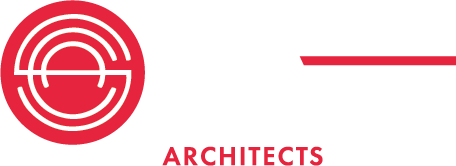As material prices continue to rise, we see an uptick in rehabilitation projects. Reimaging an existing structure while preserving the historical, cultural, and architectural features is referred to as Adaptive Reuse. Adaptive reuse projects tend to be more challenging than designing a new building. Ingenuity and problem-solving are the two leading factors in the design process.
Adaptive reuse projects allow our team to envision and design an entirely new space. For example, a 100-year-old office/warehouse project is an excellent example of how a building can transition into an efficient, productive workspace. Incorporating original architectural and unforeseen features along the way makes these designs fun and enjoyable.

Class A office space attached to a warehouse/distribution center is a rarity. However, our client, Republic National Distributing Company (RNDC), has embraced this design philosophy throughout its state locations. The design must incorporate the array of staff working within the building, including an executive team, sales reps, warehouse workers, and route drivers.
This adaptive reuse project consisted of a 100-year-old two-story warehouse with an adjacent three-story office building. The building needed to be modernized and brought to current code standards.
Initial Challenges Of The Adaptive Reuse Project
The basement of the original two-story warehouse is a fully operational distribution center that would remain intact. Moving up to the second level, it was not structurally capable of supporting heavy equipment or storing products leaving 20,000SF of unused space. Adjacent to the warehouse, a three-story office building added in 1995 connects to the warehouse through a series of stairs. The original layout has small meeting rooms and an auditorium on the basement level. The second level contains a small reception area and offices. The third floor housed the executive offices, conference rooms, executive admin, sales support, and customer service. The third floor had low ceilings making the space feel confined and dark.
A significant challenge was creating a fluid space between the warehouse and office building. In addition, the floor heights in the office addition did not match the original warehouse; finding a solution to attach the floors’ 5-6′ height difference was imperative.
The floor layout would need to be changed to incorporate our client’s needs, including executive offices, additional workspace for their growing staff, a mixology room, training areas, and reception for visitors.
The Goal
The ultimate goal was to design a beautiful, cohesive space while keeping the integrity of the building. The design would entail changing the layout on the second and third floors to have an efficient layout. Reinforcement of the structural support while keeping the original design aesthetic would need to be factored in. Expanding the third floor, increasing the height of the ceilings, and an open floor plan helps gain “connectivity” to the lower floors.
The Design
In the basement, the warehouse/distribution area remains untouched; however, space was carved out to add an exercise facility. Updates were made throughout the basement to ensure the building met code requirements, such as replacing the staircase.
By opening up the second floor, natural light flowed throughout the level while creating a visually larger space. A newly expanded reception area, open office space, and touchdown areas for the sales team would be on this level. In addition, a 200-person auditorium relocates from the basement, and a mixology room is part of the new design.


The original wood floors were beautifully refinished (as seen in the photo above of the auditorium). The uncovered gem, an 80′ exterior wall with a window system was discovered behind a wall. It received an upgrade, the glass planes were replaced with energy-efficient windows, and white frosted glazing decreased the amount of direct light. The windowed wall now lights the adjoining corridor and auditorium.

The social area, previously a freight elevator, was achieved by pouring a new slab on the second floor of the shaft.

Rounded walls and light fixtures are the dominant design element, creating a natural flow. The curvature of the NanaWall glass folding door system keeps with the theme while giving the mixology room the ability to be closed off from the open space. (photo below). Once the doors are open, the room becomes part of the open floor plan, with a view toward the open reception, the open office area, and the auditorium.
Wood slat ceilings and steel mesh “clouds” were installed, lowering the visual ceiling height. Adding these features creates an intimate space while partially concealing the exposed piping and air ducts. In addition, wood slats helped refine acoustics in the auditorium.

As for the unmatched floor levels from a previous renovation, the solution was to connect the floors with ramps. Creating a visual connection between the two buildings and bringing the space to current ADA standards. Large round light fixtures (moon rings) were installed throughout the floor, playing off the rounded walls. Over the open office space, RGB LED tape lights were installed behind glass “windows”. With infinite color-changing options, it creates visual interest. 
Last but not least, moving up to the third floor, the monumental glass and steel staircase is the focus. Not only does it connect the second and third floors but visually opens the space. It’s a visual illusion since no extra space was carved out for the new staircase. An added benefit is that the glass panels allow natural light to flow throughout the second and third floors.  The executive offices remained on the third level. By removing the ceiling tiles, the new ceiling height makes a big impact on this level. Painting the ceiling and walls white and adding mid-modern furniture completes this space. Glass replaced the conference room walls, giving the space a modern look.
The executive offices remained on the third level. By removing the ceiling tiles, the new ceiling height makes a big impact on this level. Painting the ceiling and walls white and adding mid-modern furniture completes this space. Glass replaced the conference room walls, giving the space a modern look.
To increase energy efficiency, the original industrial steel windows were replaced with a fiberglass insulated window system. Allowing natural light to fill the open office and clerestory. It was important to mimic the appearance of the original windows to not compromise the building’s facade.
Sourcing local artwork is a priority for the interiors team. The artwork in this location is all regional to Indianapolis. Landscapes, well-known monuments/places throughout the Hoosier state, and the Indianapolis 500 race track flank the walls. A large mural on the second floor is unique to the city. The original artwork (25″ by 30″) was commissioned by the city. With artist approval, the art was digitalized, increased in size, and printed onto flexible panels. The 12′ by 15′ mural now hangs in the open-air office.
Do you have a facility that needs an update?
This adaptive reuse project shows the potential for historic, mid-modern, “great location”, or “forgotten” buildings. Pairing original and modern materials give these building a unique character while giving them a new purpose. Lowering energy costs and increasing team productivity is an added bonus.
Let’s connect if you have a facility that needs an overhaul.
Our firm specializes in office interiors, shopping centers/retail, distribution/warehousing, light manufacturing, as well as having a comprehensive portfolio in restaurants, healthcare, and entertainment.
Our collaborative team specializes in Architectural & Interior Design, Planning, Programming, and Sustainability. We seek solutions with our designs by merging proven materials with new products, sustainable systems, and energy-saving technologies to offset long-term costs for our clients.


